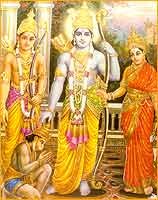Fusion |
| |
WORLD MUSIC |
|
|
RAMAYANA
THEATRE IN INDIA AND SOUTH-EAST ASIA |
| |
| The Ramayana is an immortal epic,
a "Mahakavya" in its true sense. Its greatness is indicated in the epic
itself thus: As long as the
mountain ranges stand
and rivers flow on Earth
So long will this Ramayana
Survive upon the lips of men
The influence of the theme is reflected in the
various forms of dance dramas and shadow plays in South Asia. The story of Rama seems to
have bewitched and hypnotised generations of Asians belonging to countries with religious,
literary and cultural traditions. |
| |
| The Ramayana is performed in most countries
having the Ramayana tradition. The performing tradition of the Ramayana has manifested
itself in a great range and variety of forms, having regional and stylistic variations
from the dramatic recitation of the epic story with simple mime to the highly stylised and
codified forms of dance and theatre and several forms of the puppet theatre – the
processional and ritualistic "Ramlila" of North India and in the highly
stylised and codified dance theatre "Kathakali" of Kerala; in the
highly theatrical "Khon" mask plays of Thailand and in the extremely
lyrical dance drama of Bali and the "Wayang Kulit", the puppet theatre
of Indonesia and Malaysia. While the Ramayana theatre
is an integral part of the colourful and multiform traditional theatre of Asia, it is
distinguished by many technical features. It is the most representative and artistically
rich sector of the traditional theatre often adding a new dimension to the epic story and
giving new interpretations to the characters. The epic story with its legendary and
mythical motives, eminently suits the stylised and convention-based traditional theatre of
Asian countries. |

|
|
|
| In the Ramayana tradition, the
idea of struggle between the forces of good and evil is so basic that it greatly
influences the structure and nature of theatrical forms of various types. This idea of
struggle is maintained and conveyed through a structuring of the form, peculiar to the
Ramayana Theatre. The general pattern is that in the first stage there is confrontation
between the two forces; in the second stage, challenge; in the third, conflict and combat;
and in the fourth, the victory of the good forces and defeat of the evil forces. This
pattern is followed in a variety of forms of theatre dealing with the Ramayana theme. It
is to highlight this idea of a spiritual conflict that in almost all the forms of the
Ramayana theatre, combat scenes dominate the performance, and are the most important and
dramatic. In many cases, these are also most beautifully choreographed. The performers as
well as the audience take great delight in these scenes and get a kind of spiritual
satisfaction in witnessing the defeat of the evil characters. In India, the burning of
huge effigies of Ravana and his allies on the day of the enactment of the battle between
Rama and Ravana is a grand ritualisation of this theme of the struggle between good and
evil. In the ‘Wayang Kulit’ of Indonesia, the Dalang introduces the
principal characters and suggests the beginning of the plot, a fight between good and evil
forces is the climax scene. At the end, good triumphs over evil. To be continued |
| |
| Note:
The author of this section on World music is none other than the expert Ethnomusicologist,
Dr. S A K Durga. For any doubts and queries on this subject, please mail her. |
| |
Back to World
music |
| |
